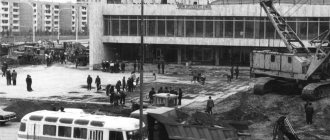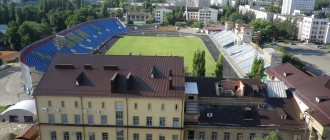Founded: 1604
City Day is celebrated
on June 7
.
The stone bridge over the Ushayka River was built at the beginning of the 20th century on the site of an old wooden bridge.
Tomsk
- a Russian city, the center of the Tomsk region, located on the Tom River, near its confluence with the Ob.
Tomsk prison
was built on October 7, 1604, a few months earlier - on
June 7, 1604
- the first Cossacks appeared here on the banks of the Tom River. In the 17th century, it became famous as a fortress that repeatedly repelled the raids of nomads. Since 1629, Tomsk received the status of a city. In the 18th century, the defensive importance of the fortress decreased, and Tomsk became a center of transit trade.
In 1782, Tomsk received the status of a regional city of the Tobolsk governorship. In 1804, the city became the center of the Tomsk province, which included the territories of the current Altai Territory, Kemerovo, Novosibirsk and Tomsk regions, East Kazakhstan region (Kazakhstan) and part of the Krasnoyarsk Territory.
The active growth of Tomsk began in the late 30s of the 19th century. Gold mines were discovered in the Tomsk province. Tomsk was famous for its artisans; 35 different types of crafts were registered in the city. By the beginning of the 20th century, there were 208 plants and factories in Tomsk. The city had electric lighting, trams, and a telephone network.
Tomsk was also known in these times as a city of exile.
Epiphany Cathedral The city becomes the educational center of Siberia. In 1888, the first university in Siberia was opened in Tomsk, and in 1900, the Technological Institute.
During the Great Patriotic War, more than 30 enterprises from the Western part of Russia were evacuated to Tomsk. In August 1944, the Tomsk region was formed, Tomsk became the regional center. In 1970, Tomsk was given the status of a historical city.
By Decree of the President of the Russian Federation dated July 2, 2022, Tomsk was awarded the honorary title of Russian Federation for the significant contribution of city residents to achieving Victory in the Great Patriotic War of 1941–1945, ensuring uninterrupted production of military and civilian products at industrial enterprises, and for the massive labor heroism and dedication shown. Federation " City of Labor Valor"
».
Tomsk is widely known
stunning wooden architecture. It is also worth visiting the Epiphany Cathedral, the stock exchange, the Flour Building, the governor's house, and the Stone Bridge.
Interesting
that Tomsk has its own “Tomsk Grail”. This is the name of the lime bowls with water (Talovskie bowls) - a natural monument located not far from the city. It is assumed that these bowls are the prototype of the image of the Holy Grail, which was brought to Europe by the Goths from Siberia.
The city has a population of about 568 thousand people (as of 2022).
Day of the city
Tomsk celebrates June 7 in honor of the memorable date.
Coat of arms
In May 1729, Emperor Peter II approved the first coat of arms of Tomsk. The coat of arms reflected the significance of the ore deposits of the Tomsk district for the state. In 1785, a silver horse appeared on the coat of arms of Tomsk for the first time, remaining a symbol of the city to this day. It symbolizes: “the horses of this area are considered the best, and the Tatars living near them have horse stud farms.” In 2003, the modern coat of arms of Tomsk was approved, in addition to a silver horse on a green shield, a gold crown and the motto “THE LABOR AND KNOWLEDGE” were added.
Films about Tomsk
One of the most interesting films dedicated to this locality is “Orthodox Tomsk”. The film tells about the first local monastery and about religious life since the founding of the city. Also of great interest to tourists is the video guide from the “March Tour” series, which tells about the history of Tomsk and its main attractions.
Figure 4. A time of universal joy
A visit to the bright celebration will be remembered for a long time by both tourists and Tomsk residents.
Alexander, May 24, 2022.
Features of the holiday
If a holiday falls on a working day, public events are usually postponed to the weekend. Round dates are celebrated more solemnly. On this day, many good words are said from city scenes about Tomsk and its residents. Local artists sing songs about their beloved city, and theaters stage productions dedicated to important moments in history. Outstanding Tomsk residents and residents of the region receive awards, cash prizes, and memorial certificates.
Figure 2. Highlights of the celebration
Airport
The operating Tomsk international airport "Bogashevo" is located outside the city limits, 20 kilometers from the city. The railway station of the same name closest to the air terminal is located 4.5 kilometers away.
The geography of Bogashevo flights covers many Russian and foreign cities. Popular destinations within the country are Moscow, Krasnoyarsk, Novosibirsk, Yekaterinburg, Kazan, Surgut, Barnaul, Abakan. During the tourist seasons, direct flights are made from Tomsk airport to the resort cities of Egypt, Turkey, Spain, Thailand and other countries.
A special bus runs between Bogashevo Airport and Tomsk, picking up passengers from the central bus station (Kirova Avenue), microdistrict No. 2 and Lenin and Yuzhnaya squares. The bus route also passes through Loskutovo, an urban village located 7 kilometers from the airport.
City information
Tomsk is the administrative center of the region of the same name in the Russian Federation. It is located in the east of Western Siberia, off the coast of Tom. The economy is represented by enterprises in the petrochemical, energy generating, food, and construction industries. There are service and trade companies operating.
Important highways pass near the settlement: M53 “Baikal”, P400, P398. There is a major railway junction of the Trans-Siberian Railway. Bogashevo International Airport is located nearby. There are vocational educational institutions, universities and their branches. The population is more than 560 thousand people.
The population of Tomsk in 2022 decreased by almost 8 thousand people
TOMSK, March 17 – RIA Tomsk. Tomsk authorities predicted the urban population to be 602.5 thousand people for 2022, but it did not reach 590 thousand people; Natural population decline amounted to 1.8 thousand people, migration – over 6 thousand, according to the draft report of the mayor of Tomsk for 2022, posted on the City Duma website.
The mayor of Tomsk makes an annual report to city Duma deputies. The text of the document is previously discussed in committees, where deputies express their proposals regarding the plans of the municipal government for the coming year. The draft report of the mayor was published on the website of the Tomsk City Duma. The duties of mayor are temporarily performed by Mikhail Ratner.
It follows from the text that in recent years Tomsk has experienced an increase in the urban population, so for 2022 the authorities predicted a figure of 602.5 thousand people, but the figures turned out to be significantly lower.
“As of January 1, 2022, the population in the city of Tomsk was 589,844 people. Natural decline – 1,803 people, migration decline – 6,172 people,” the document says and notes that the working-age population was 370.6 thousand people (62.8%), over working age – 113.2 thousand (19 .2%), younger (up to 15 years inclusive) – 106 thousand people (18%).
It is reported that natural decline in 2022 consisted of 5,100 births and 6,903 deaths. A decrease in the number of births has been recorded in the city since 2016. The fertility rate (the number of children born to 1 woman) in 2022 was 0.95 (4% less than in 2022), and the mortality rate in 2022 increased by 22.3%. One of the reasons for population decline is the spread of COVID 19.
© RIA Tomsk. Taisiya Vorontsova
Over the past 5 years, on average, Tomsk residents have “matured” by a year
“Due to restrictions on the migration movements of citizens introduced to prevent the spread of coronavirus infection COVID-19, in 2022 a migration loss of Tomsk residents was recorded in the amount of 6,172 people (in 2022, due to migration processes, the population of the city of Tomsk increased by 1,526 people ),” the report says.
At the same time, the intraregional migration decline amounted to 2,416 people (3,840 people arrived, 6,256 people left), interregional - 3,300 people (5,521 people arrived, 8,821 people left), international - 456 people (4,678 people arrived, dropped out - 5,134 people).
It was previously reported that, according to preliminary data, the population of the Tomsk region decreased in 2022 by 8,755 people, while the natural population decline amounted to 4,338 people, and the migration one - 4,417 people. According to TASS, the population of the Russian Federation in 2020 decreased by 0.5 million people. The last time a similar situation occurred was in 2005, when the country's population decreased by 564.5 thousand people.
Tomsk Square, 11 pcs.
Academician Zuev Square
Fresh education in Tomsk, located near Akademgorodok, and nearby Koroleva and Akademicheskaya streets. Very little time has passed since this public space began to exist on February 17, 2004 under the name of Academician V. Zuev. Physically, the square was formed as a transport ring of Korolev Street and Academic Avenue. The size of the entire zone stretches over 60,000 square meters.
Batenkov Square
The place of foundation is between Gagarin, Sovetskaya, Krylov streets and two lanes - Batenkova and Pionersky. Once upon a time there was an old church here, but it was removed back in the 30s. Moreover, there was even a mini-tomb here. Today, a small but beautiful monument to Batenkov has been erected here, with benches and a place for walking around. Around the site there is noise from trams in all directions.
Dzerzhinsky Square
This is the Kirovsky district of Tomsk, and specifically the area around Kirovka and Dzerzhinsky streets (hence the name). In this case, the tram lines also intersect on both sides. There is a beautiful boulevard adjacent to it. I operate stops for trolleybuses, buses and trams with the same name.
Zhukov Square
It is stationed on Kashtak, where there is Govorova Street and the 79th Guards Division. The territory bears the name of the famous military man Georgy Zhukov, who lived in the USSR. When he turned 100 years old from his birthday, they decided to decorate the square on February 28, 1996 with the name of the commander. But the name didn’t really catch on; people often interpret this area as a “circle at the car market,” due to its direct connection with the Kashtachny car market.
Kirov Square
Mainly at the intersection of Komsomolsky Avenue and Kirov Avenue. From here you can go to the Tomsk I district. The tram network is continued in this part of the city, there is even an additional function for rearranging the route using an arrow.
Horse Square
Initially there was a place for selling horses, then it was designated as a street. “Horse”, then the name grew into “Horse Lane”. By the end of the 19th century, it was given the status of “Horse Square”. Thermal power plant No. 1 is located nearby; a lot of territory has been allocated for construction. There is no market now.
Kukin Square
The basis for the square is Mokrushina Street. The Tomsk Radio Engineering Plant recently operated here. Local officials funny and emotional discovered the wonder of the world on December 14, 2009 and from now on the site is referred to as “Kukina”. Check out the image on the right.
Lenin Square
At first it was called vulgarly “Bazarnaya”, then “Bazarno-Gostinodvorskaya”, and even so “Bogoyavlenskaya”, “Main Bazarnaya”, “Gostinodvorskaya”, “Iverskaya”, “Torgovaya”. Clear formulations, because this is the main street of the city and the entire region! Apparently there were more than enough traders here - they became symbols of the formation of such words. But with ardent communism in 1959, Lenin also began to rule on this main street.
Novosobornaya Square
This is the main place of the city. A New Year tree is put up here, people are constantly walking here. It is civilized and beautiful here in the morning, afternoon and evening. Life is in full swing here in spring, summer, winter and autumn. Legally called through a dash, “Novo-Sobornaya”, is the center of Tomsk. Once upon a time it was simply called one word without the prefix “Novo”. This is the old district of Nizhnyaya Yelan.
station Square
Everything speaks for itself. People walk here and there, cars make similar waves along the road. It is located in the Kirovsky district of Tomsk, ending at Kirov Avenue. Logically, there are bus and train stations nearby. Regarding the name, it is more popular and not legally established.
Salt Square
The square is dissected by Makushina Lane, followed by the street. Pushkin. Once upon a time the name of the site was “Proviantskaya”. Further, in 1979, the square began to be called “Architect Kryachkov Street,” but then they changed their mind a year later and removed the name. Nearby there is a regional court, an architectural university, a pizzeria, a house of science, a theater, and monuments. An iconic place. Buses and trolleybuses cross the square. Life is in full swing.
Transport area
This is the Kirovsky district of Tomsk, the most difficult to remember among residents. People often confuse it with the Southern one (which will be discussed later). Nakhimov and Elizarov streets connect this section of the road. If you move a little away, the street will be nearby. Kyiv (it’s just typical there, literally 100 meters).
South Square
The same area as the previous area. It sounds widely in the mouths of Tomsk citizens. It is often called Transport Square. What is this connected with? It is not known exactly. They are probably located nearby and are on the same administrative division.
A little about the center of Tomsk
Stop in Tomsk, one of the oldest cities in Siberia
Zyryanskoe (Tomsk region)
Bely Yar (Tomsk region)
City of Seversk (Tomsk region)
Kedrovy, Tomsk region
Tomsk 2022 website
Mavlyukeevskoye Lake
White Lake Tomsk
Automobile highways
The following roads approach Tomsk:
- The federal highway P255 “Siberia” (formerly M53) connects Tomsk with Novosibirsk, Kemerovo, Krasnoyarsk and Irkutsk. It is a continuation of the P254 Irtysh road, running from Novosibirsk to Chelyabinsk through Omsk and Kurgan.
- Regional road P398 "Shegarsky tract" to Kolpashevo - a city in the Tomsk region. Currently, construction is underway on the Northern Latitudinal Highway, which will be a continuation of the P398 highway with a terminal point in Perm, after which the road will probably have federal status.
- The regional highway “Irkutsk Tract” connects Tomsk with the Teguldetsky, Zyryansky, Pervomaisky and Asinovsky districts of the Tomsk region.
- Regional highway east from Tomsk to Mirny and further to Basandaika.
- "Bogashevsky tract" - the road to the Bogashevo airport.
- “Kolarovsky tract” is a route to the village of Yar (Yarskoye) and the pier of the same name on Tom.
Fishing and hunting on the Tom River
This hydrological object is famous for all kinds of fish. The ichthyfauna includes the following species:
- pike;
- crucian carp;
- ruff;
- perch;
- peled;
- muksun;
- Siberian sturgeon;
- grayling;
- lamprey;
- sculpin;
- sterlet;
- chum salmon;
- arctic char.
There were once 29 species of fish living here. But the anthropogenic factor changed everything. Representatives of half of the families listed are almost never caught. Not only has man polluted everything here and scared away the aquatic life. He also shallowed the stream, extracting sand mixture from many water edges. So, pike, crucian carp and perch.
On the Tom River, fishing produces results everywhere except large cities and the industrial sector (with its accompanying emissions). Fishing is also prohibited in 5 water protection zones. The rest of the river is entirely yours. It is worth remembering the rules of spawning (there are spawning grounds here). And also release back the “Red Book” lamprey, Siberian sturgeon, chum salmon, Arctic char, sculpin, taimen. In the dirty pond they became rare fish.
Having talked about the pleasure the Tom River gives to fishermen, let’s finish describing fishing. What about hunting? It is difficult to imagine a more populated river in Siberia than the Tom. Its middle and lower sections are a continuous line of cities, industrial complexes, towns, large villages, hamlets, tourist and fishing bases. The very lower reaches are a complex of nature reserves. Between them there are farms where they shoot only duck, goose, hazel grouse, partridge and wild boar. Shooting in the rest of the zone (residential and “custom” zones), as you understand, is prohibited. As for the upper river episode, some part of it concerns the buffer zone of the Kuznetsky Alatau nature reserve. But everything else belongs to publicly accessible hunting grounds. This is the Republic of Khakassia. Let's talk about her.
Askizsky district (Kharasaban and Kuznetsky Alatau lands) is rich in deer, brown bear, lynx, badger and sable (shooting of all these species is limited). But there is a wolf, a fox, a hare, a squirrel, and a wolverine. Upland game includes partridge, black grouse, capercaillie, hazel grouse and woodcock. Various ducks (except for the red-breasted grebe) and goose are available from the swamp lake. The local Red Book includes flying squirrel, manul, bats, mink, musk deer, birds of prey and owls. Also near-water game: swans, herons, cranes and storks.









